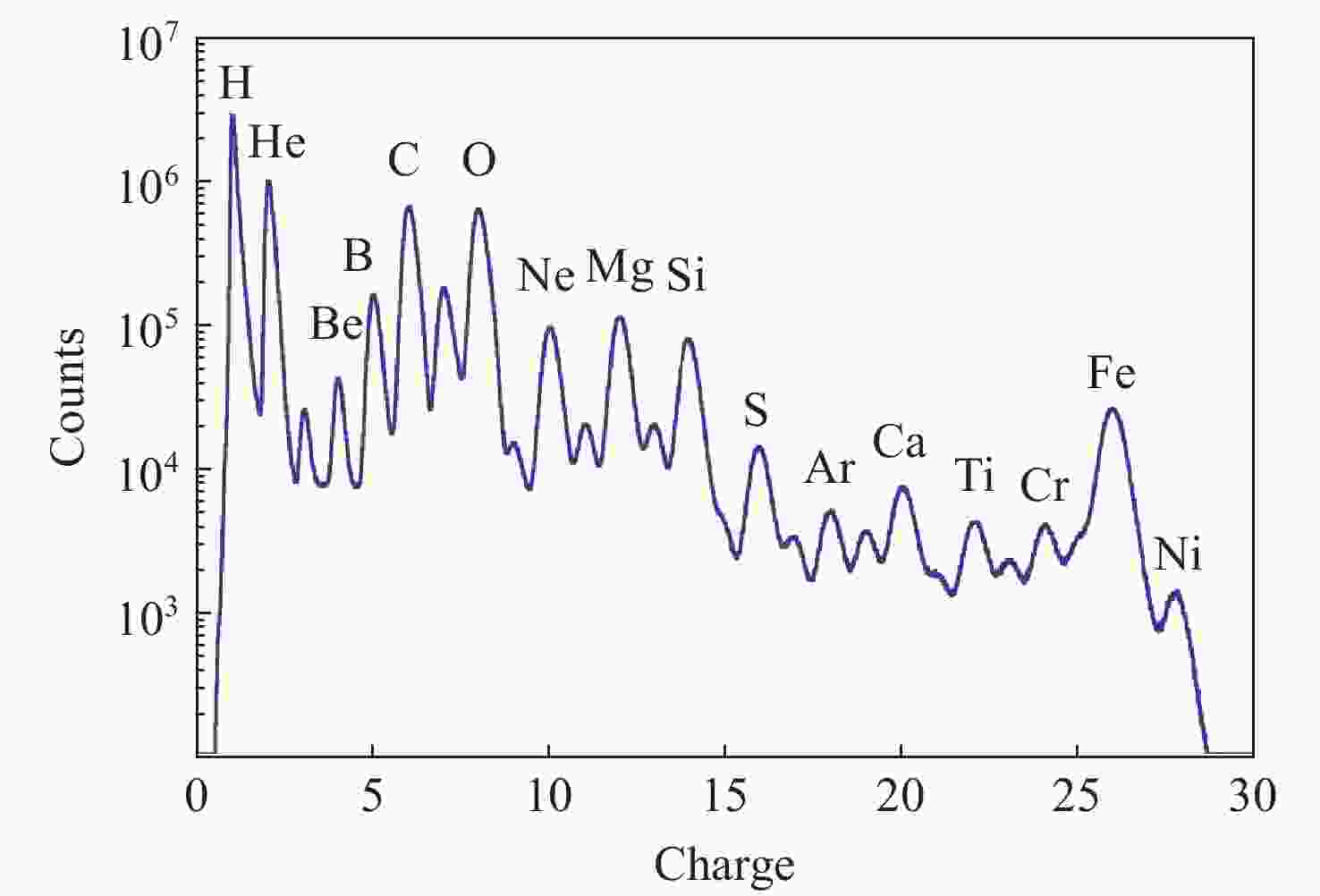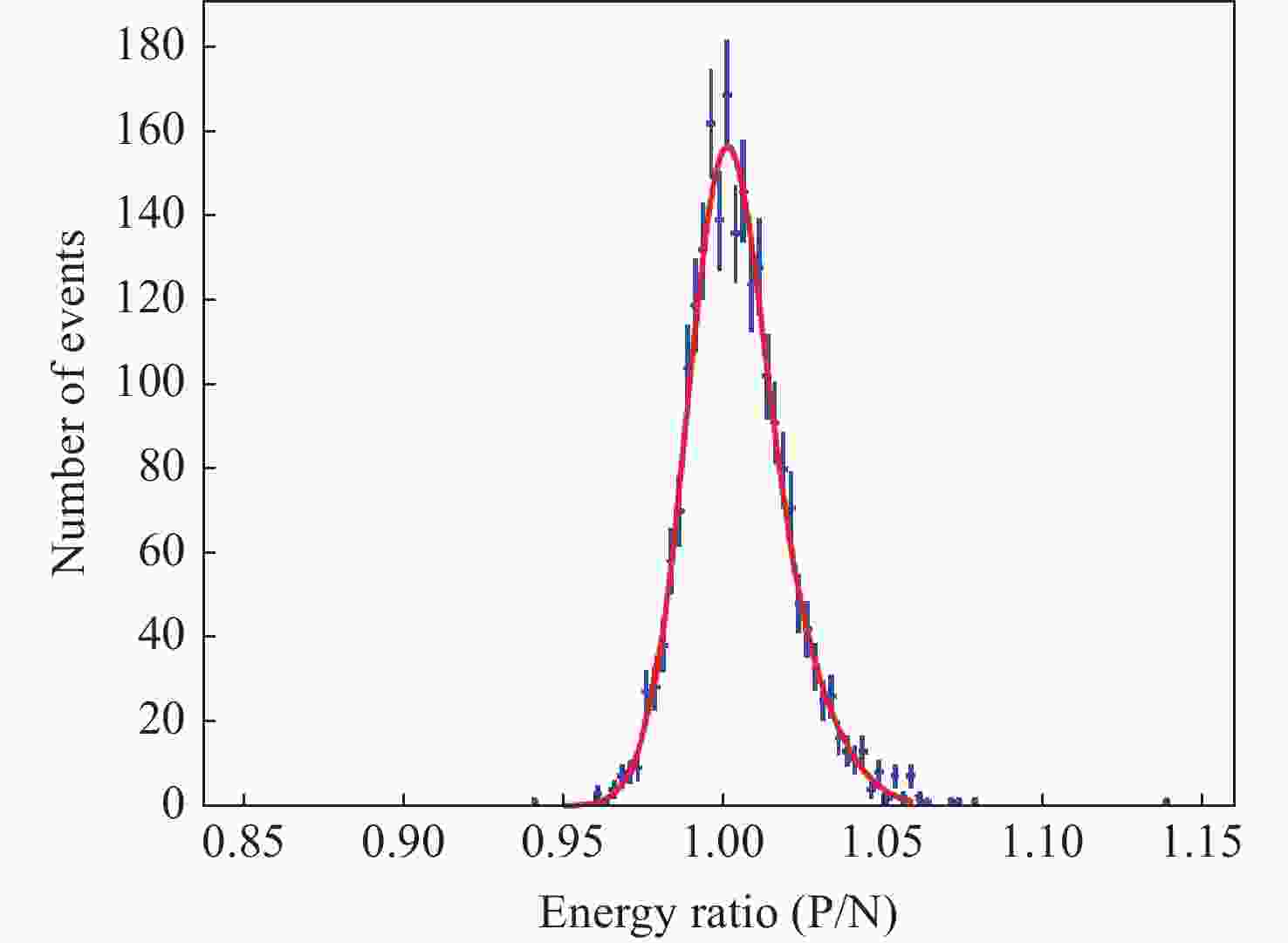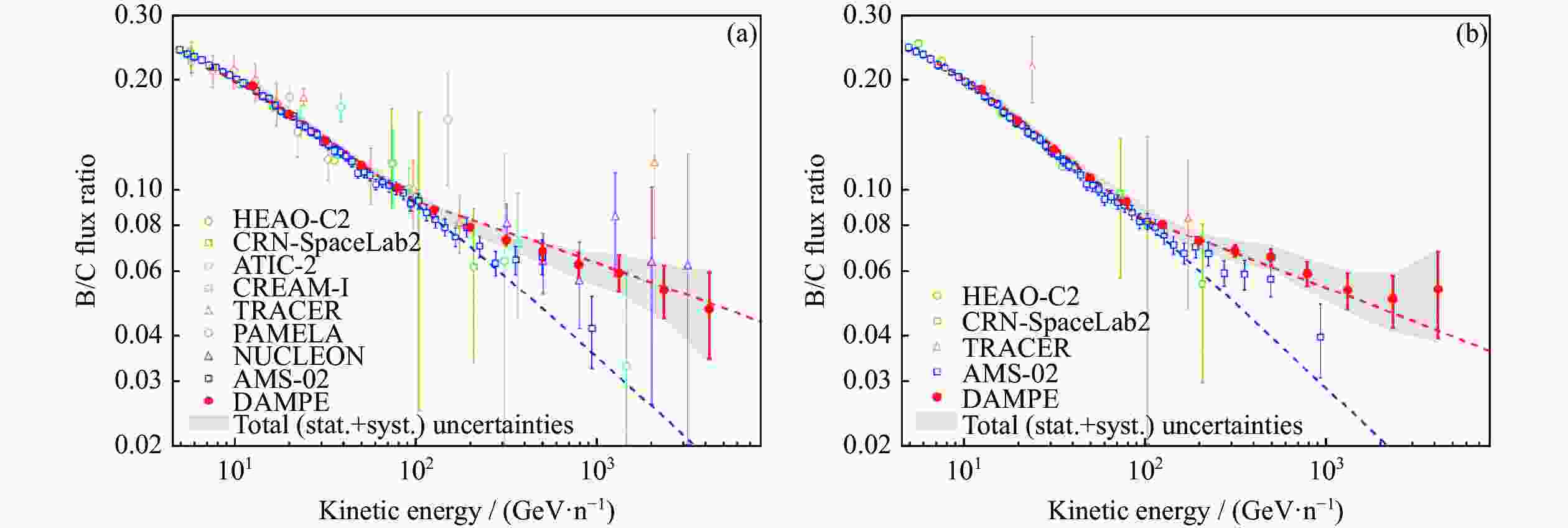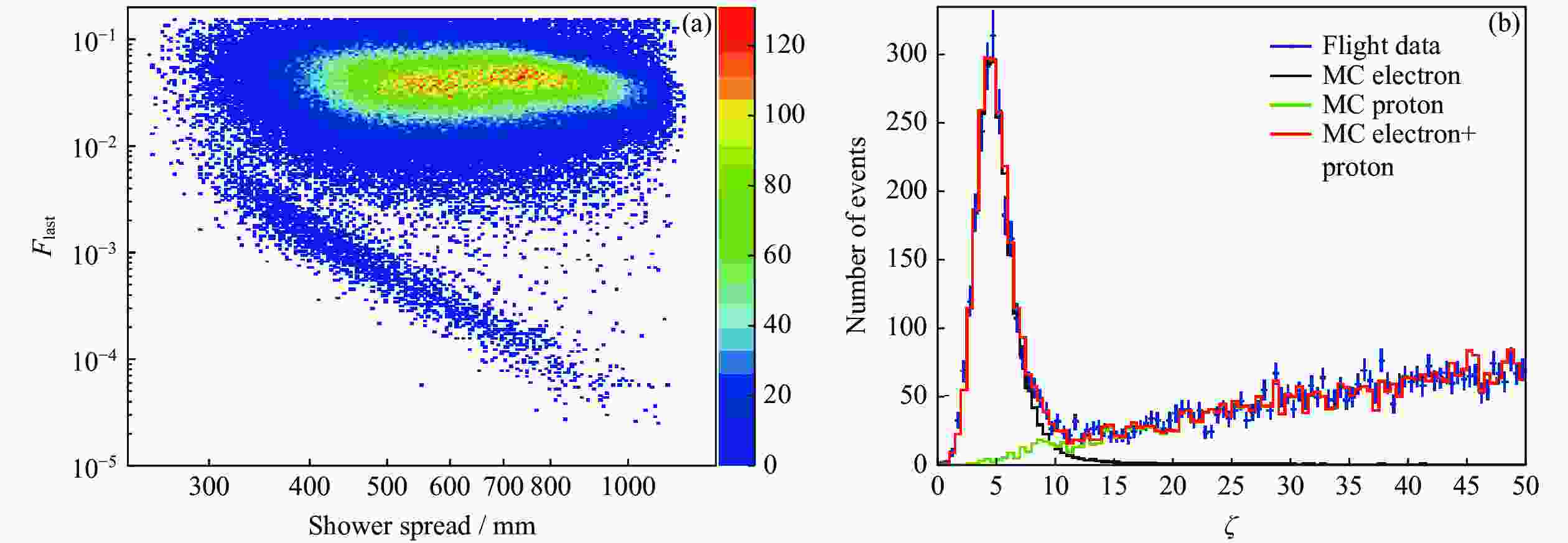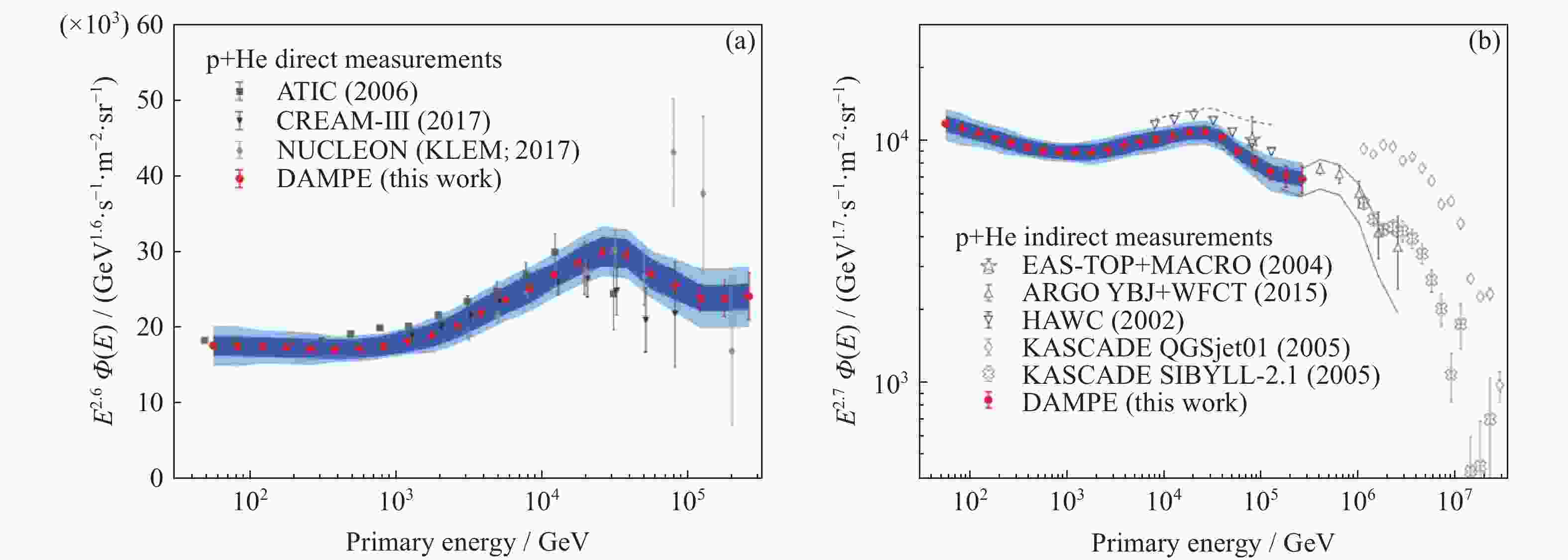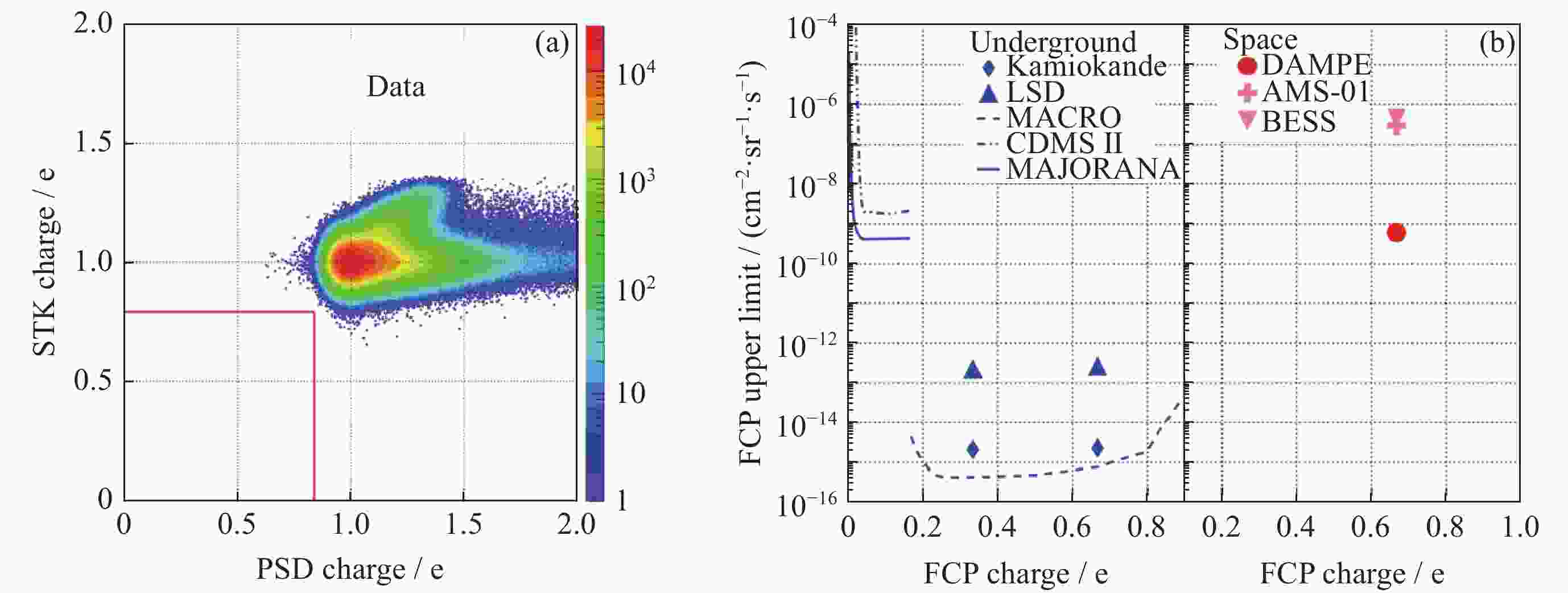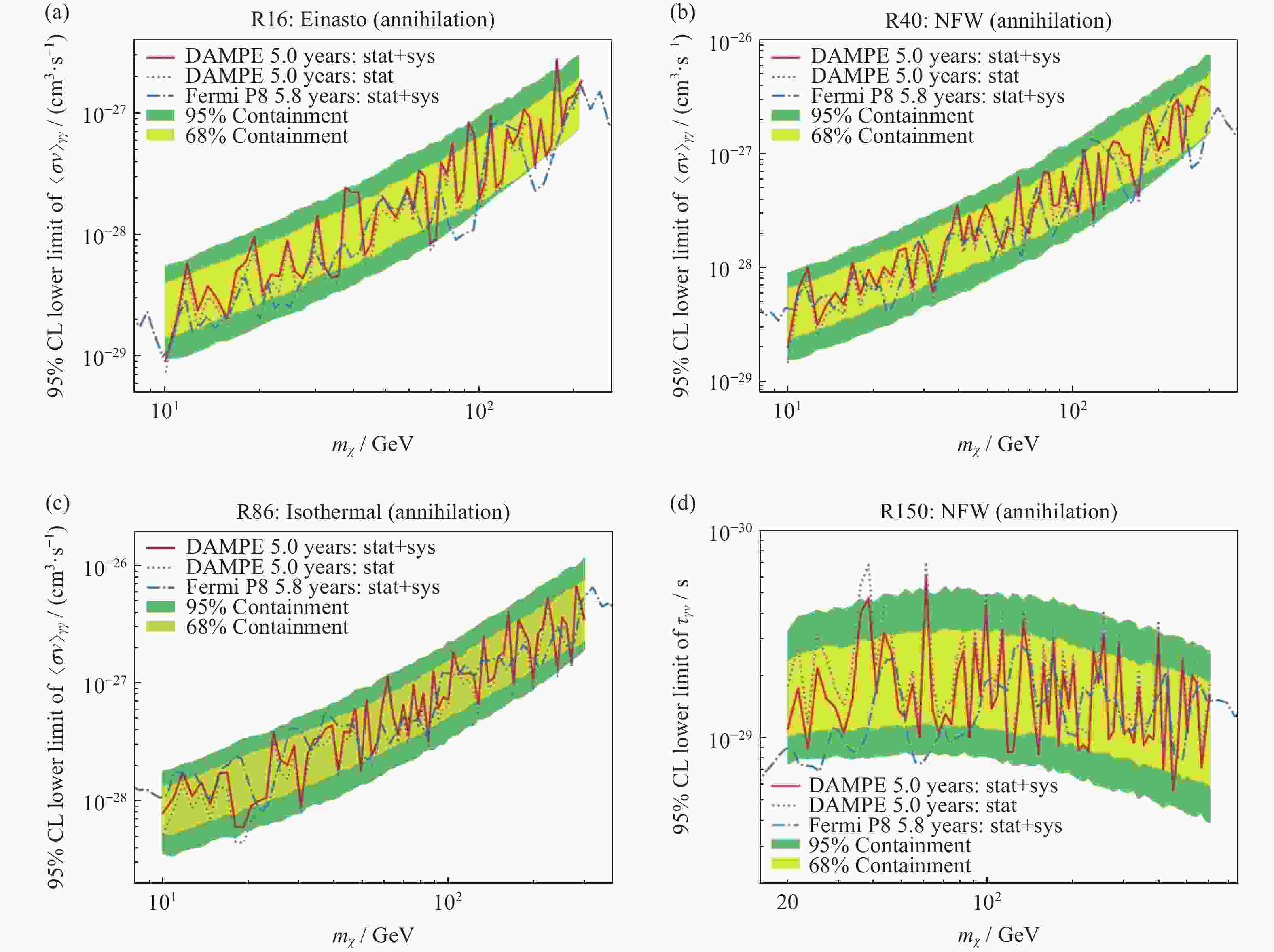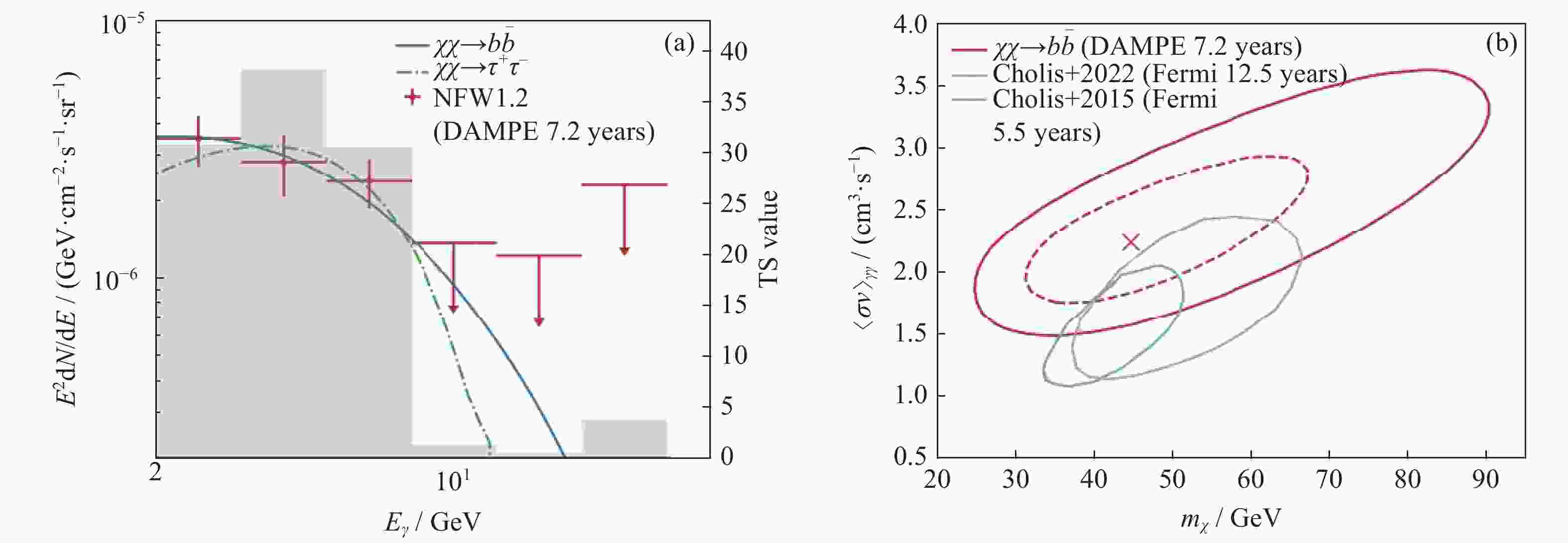Recent Progresses of the DAMPE Mission
doi: 10.11728/cjss2024.04.2024-yg11 cstr: 32142.14.cjss2024.04.2024-yg11
-
Abstract: The DArk Matter Particle Explorer (DAMPE) is a space high-energy particle and γ-ray detector whose major scientific goals are the indirect detection of dark matter particles, the origin of cosmic rays and high-energy γ-ray astronomy. Since its successful launch in December 2015, the DAMPE has been operated smoothly in orbit for more than 8 years. The direct measurements of the boron-to-carbon and boron-to-oxygen flux ratios, and the proton+ Helium spectrum up to 316 TeV have been obtained, revealing new spectral features with very high significances. The search results of γ-ray spectral line and fractionally charged particles indicate a good potential of DAMPE for indirect dark matter detection and new physical discovery in space. The DAMPE measurements are expected to significantly advance our understanding of the fundamental problems in astroparticle physics.
-
Key words:
- DAMPE /
- Dark matter /
- Indirect detection /
- Cosmic rays
-
Figure 9. Significant point sources (TS≥25) detected in 7.2-year DAMPE data[65]. Markers present the types of the associated sources. The numbers of different source types are listed in the right table
Figure 10. Preliminary spectral measurement of the Galactic center excess (GCE) by DAMPE (a) and the preferred DM parameter space for the annihilation channel $ {\chi }{\chi }\to b\bar{b} $ (b)[68]
Table 1. Expected performance of DAMPE
Parameter Value Energy range (e/γ) 5 GeV to 10 TeV Energy resolution (e/γ) 1.5% at 800 GeV Energy range (p) 50 GeV to 500 TeV Energy resolution (p) 40% at 800 GeV Effective area (vertical γ) 1100 cm2 at 100 GeV Geometry factor (e) 0.3 m2·sr above 30 GeV Angular resolution (γ) 0.1º at 100 GeV Field of view 1.0 sr -
[1] ADE P A R, AGHANIM N, ARNAUD M, et al. Planck 2015 results. XIII. Cosmological parameters[J]. Astronomy & Astrophysics, 2016, 594 : A13 [2] JUNGMAN G, KAMIONKOWSKI M, GRIEST K. Supersymmetric dark matter[J]. Physics Reports, 1996, 267(5/6): 195-373 [3] BERTONE G, HOOPER D, SILK J. Particle dark matter: evidence, candidates and constraints[J]. Physics Reports, 2005, 405(5/6): 279-390 [4] BI X J, YIN P F, YUAN Q. Status of dark matter detection[J]. Frontiers of Physics, 2013, 8(6): 794-827 doi: 10.1007/s11467-013-0330-z [5] ZHAO L, LIU J L. Experimental search for dark matter in China[J]. Frontiers of Physics, 2020, 15(4): 44301 doi: 10.1007/s11467-020-0960-x [6] ADRIANI O, BARBARINO G C, BAZILEVSKAYA G A, et al. An anomalous positron abundance in cosmic rays with energies 1.5-100 GeV[J]. Nature, 2009, 458(7238): 607-609 doi: 10.1038/nature07942 [7] ACKERMANN M, AJELLO M, ALLAFORT A, et al. Measurement of separate cosmic-ray electron and positron spectra with the Fermi Large Area Telescope[J]. Physical Review Letters, 2012, 108(1): 011103 doi: 10.1103/PhysRevLett.108.011103 [8] AGUILAR M, ALBERTI G, ALPAT B, et al. First result from the Alpha Magnetic Spectrometer on the International Space Station: precision measurement of the positron fraction in primary cosmic rays of 0.5-350 GeV[J]. Physical Review Letters, 2013, 110(14): 141102 doi: 10.1103/PhysRevLett.110.141102 [9] CHANG J, ADAMS J H, AHN H S, et al. An excess of cosmic ray electrons at energies of 300-800 GeV[J]. Nature, 2008, 456(7220): 362-365 doi: 10.1038/nature07477 [10] ABDO A A, ACKERMANN M, AJELLO M, et al. Measurement of the cosmic ray e++e- spectrum from 20 GeV to 1 TeV with the Fermi Large Area telescope[J]. Physical Review Letters, 2009, 102(18): 181101 doi: 10.1103/PhysRevLett.102.181101 [11] AGUILAR M, AISA D, ALPAT B, et al. Precision measurements of the (e++e-) flux of the primary cosmic rays from 0.5 GeV to 1 TeV with the Alpha magnetic spectrometer on the international space station[J]. Physical Review Letters, 2014, 113 (22/23/24/25/26/27/28): 221102 [12] SHEN C S. Pulsars and very high-energy cosmic-ray electrons[J]. The Astrophysical Journal, 1970, 162: L181 doi: 10.1086/180650 [13] HOOPER D, BLASI P, SERPICO P D. Pulsars as the sources of high energy cosmic ray positrons[J]. Journal of Cosmology and Astroparticle Physics, 2009, 1: 25 [14] YÜKSEL H, KISTLER M D, STANEV T. TeV gamma rays from Geminga and the origin of the GeV positron excess[J]. Physical Review Letters, 2009, 103(5): 051101 doi: 10.1103/PhysRevLett.103.051101 [15] BERGSTRÖM L, BRINGMANN T, EDSJÖ J. New positron spectral features from supersymmetric dark matter: a way to explain the PAMELA data?[J]. Physical Review D, 2008, 78(10): 103520 doi: 10.1103/PhysRevD.78.103520 [16] CIRELLI M, KADASTIK M, RAIDAL M, et al. Model-independent implications of the e±, $ \bar{p} $ cosmic ray spectra on properties of dark matter[J]. Nuclear Physics B, 2009, 813(1/2): 1-21 [17] YIN P F, YUAN Q, LIU J, et al. PAMELA data and leptonically decaying dark matter[J]. Physical Review D, 2009, 79(2): 023512 doi: 10.1103/PhysRevD.79.023512 [18] ABEYSEKARA A U, ALBERT A, ALFARO R, et al. Extended gamma-ray sources around pulsars constrain the origin of the positron flux at Earth[J]. Science, 2017, 358(6365): 911-914 doi: 10.1126/science.aan4880 [19] HOOPER D, GOODENOUGH L. Dark matter annihilation in the Galactic center as seen by the Fermi gamma ray space telescope[J]. Physics Letters B, 2011, 697(5): 412-428 doi: 10.1016/j.physletb.2011.02.029 [20] CUI M Y, YUAN Q, TSAI Y L S, et al. Possible dark matter annihilation signal in the AMS-02 antiproton data[J]. Physical Review Letters, 2017, 118(19): 191101 doi: 10.1103/PhysRevLett.118.191101 [21] CUOCO A, KRÄMER M, KORSMEIER M. Novel dark matter constraints from antiprotons in light of AMS-02[J]. Physical Review Letters, 2017, 118(19): 191102 doi: 10.1103/PhysRevLett.118.191102 [22] CHANG J. Dark matter particle explorer: the first Chinese cosmic ray and hard γ-ray detector in Space[J]. Chinese Journal of Space Science, 2014, 34(5): 550-557 doi: 10.11728/cjss2014.05.550 [23] CHANG J, AMBROSI G, AN Q, et al. The dark matter particle explorer mission[J]. Astroparticle Physics, 2017, 95: 6-24 doi: 10.1016/j.astropartphys.2017.08.005 [24] YU Y H, SUN Z Y, SU H, et al. The plastic scintillator detector for DAMPE[J]. Astroparticle Physics, 2017, 94: 1-10 doi: 10.1016/j.astropartphys.2017.06.004 [25] AZZZARELLO P, AMBROSI G, ASFANDIYAROV R, et al. The DAMPE silicon-tungsten tracker[J]. Nuclear Instruments and Methods in Physics Research Section A: Accelerators, Spectrometers, Detectors and Associated Equipment, 2016, 831: 378-384 [26] ZHANG Z Y, ZHANG Y L, DONG J N, et al. Design of a high dynamic range photomultiplier base board for the BGO ECAL of DAMPE[J]. Nuclear Instruments and Methods in Physics Research Section A: Accelerators, Spectrometers, Detectors and Associated Equipment, 2015, 780: 21-26 [27] HE M, MA T, CHANG J, et al. GEANT4 simulation of neutron detector for DAMPE[J]. Acta Astronomica Sinica, 2016, 57(1): 1-8 [28] AMBROSI G, AN Q, ASFANDIYAROV R, et al. The on-orbit calibration of DArk matter particle explorer[J]. Astroparticle Physics, 2019, 106: 18-34 doi: 10.1016/j.astropartphys.2018.10.006 [29] DONG T K, ZHANG Y P, MA P X, et al. Charge measurement of cosmic ray nuclei with the plastic scintillator detector of DAMPE[J]. Astroparticle Physics, 2019, 105: 31-36 doi: 10.1016/j.astropartphys.2018.10.001 [30] YUE C, ZANG J J, DONG T K, et al. A parameterized energy correction method for electromagnetic showers in BGO-ECAL of DAMPE[J]. Nuclear Instruments and Methods in Physics Research Section A: Accelerators, Spectrometers, Detectors and Associated Equipment, 2017, 856: 11-16 [31] DAMPE Collaboration. Direct detection of a break in the teraelectronvolt cosmic-ray spectrum of electrons and positrons[J]. Nature, 2017, 552(7683): 63-66 doi: 10.1038/nature24475 [32] CHANG J. On the detection and identification of cosmic gamma-rays in a cosmic ray detector[C]//26th International Cosmic Ray Conference. Salt Lake City: ICRC, 1999: 37 [33] CHANG J, ADAMS J H, AHN H S, et al. Resolving electrons from protons in ATIC[J]. Advances in Space Research, 2008, 42(3): 431-436 doi: 10.1016/j.asr.2007.06.012 [34] HUANG Y Y, MA T, YUE C, et al. Calibration and performance of the neutron detector onboard of the DAMPE mission[J]. Research in Astronomy and Astrophysics, 2020, 20(9): 153 doi: 10.1088/1674-4527/20/9/153 [35] DAMPE Collaboration. Detection of spectral hardenings in cosmic-ray boron-to-carbon and boron-to-oxygen flux ratios with DAMPE[J]. Science Bulletin, 2022, 67(21): 2162-2166 doi: 10.1016/j.scib.2022.10.002 [36] HERD Collaboration. The high energy cosmic-radiation detection (HERD) facility onboard China’s Space Station[J]. Proc. SPIE, 2014, 9144: 91440X [37] ENGELMANN J J, FERRANDO P, SOUTOUL A, et al. Charge composition and energy spectra of cosmic-ray for elements from Be to Ni - Results from HEAO-3-C2[J]. Astronomy & Astrophy- sics, 1990, 233: 96-111 [38] SWORDY S P, MUELLER D, MEYER P, et al. Relative abundances of secondary and primary cosmic rays at high energies[J]. The Astrophysical Journal, 1990, 349: 625 doi: 10.1086/168349 [39] PANOV A D, SOKOLSKAYA N V, ADAMS J H, et al. Relative abundances of cosmic ray nuclei B-C-N-O in the energy region from 10 GeV/n to 300 GeV/n. Results from ATIC-2 (the science flight of ATIC)[C]//30th International Cosmic Ray Conference. Merida: ICRC, 2007: 3 [40] AHN H S, ALLISON P S, BAGLIESI M G, et al. Measurements of cosmic-ray secondary nuclei at high energies with the first flight of the CREAM balloon-borne experiment[J]. Astroparticle Physics, 2008, 30(3): 133-141 doi: 10.1016/j.astropartphys.2008.07.010 [41] OBERMEIER A, AVE M, BOYLE P, et al. Energy spectra of primary and secondary cosmic-ray nuclei measured with TRACER[J]. The Astrophysical Journal, 2011, 742(1): 14 doi: 10.1088/0004-637X/742/1/14 [42] ADRIANI O, BARBARINO G C, BAZILEVSKAYA G A, et al. Measurement of boron and carbon fluxes in cosmic rays with the PAMELA experiment[J]. The Astrophysical Journal, 2014, 791(2): 93 doi: 10.1088/0004-637X/791/2/93 [43] GREBENYUK V, KARMANOV D, KOVALEV I, et al. Secondary cosmic rays in the NUCLEON space experiment[J]. Advances in Space Research, 2019, 64(12): 2559-2563 doi: 10.1016/j.asr.2019.06.030 [44] AGUILAR M, ALI CAVASONZA L A, AMBROSI G, et al. The Alpha Magnetic Spectrometer (AMS) on the International Space Station: Part II — results from the first seven years[J]. Phy sics Reports, 2021, 894: 1-116 doi: 10.1016/j.physrep.2020.09.003 [45] DAMPE Collaboration. Measurement of the cosmic p+He energy spectrum from 46 GeV to 316 TeV with the DAMPE space mission[OL]. arXiv preprint arXiv: 2304.00137, 2023 [46] COLLABORATION D, ASFANDIYAROV R, AZZARELLO P, et al. (DAMPE Collaboration). Measurement of the cosmic ray proton spectrum from 40 GeV to 100 TeV with the DAMPE satellite[J]. Science Advances, 2019, 5(9): eaax3793 doi: 10.1126/sciadv.aax3793 [47] ALEMANNO F, AN Q, AZZARELLO P, et al. Measurement of the cosmic ray helium energy spectrum from 70 GeV to 80 TeV with the DAMPE space mission[J]. Physical Review Letters, 2021, 126(20): 201102 doi: 10.1103/PhysRevLett.126.201102 [48] AHN H S, SEO E S, ADAMS J H, et al. The energy spectra of protons and helium measured with the ATIC experiment[J]. Advances in Space Research, 2006, 37(10): 1950-1954 doi: 10.1016/j.asr.2005.09.031 [49] ATKIN E, BULATOV V, DOROKHOV V, et al. First results of the cosmic ray NUCLEON experiment[J]. Journal of Cosmology and Astroparticle Physics, 2017, 2017: 20 [50] AHN H S, ALLISON P, BAGLIESI M G, et al. Discrepant hardening observed in cosmic-ray elemental spectra[J]. The Astrophysical Journal Letters, 2010, 714(1): L89-L93 doi: 10.1088/2041-8205/714/1/L89 [51] BARTOLI B, BERNARDINI P, BI X J, et al. Knee of the cosmic hydrogen and helium spectrum below 1 PeV measured by ARGO-YBJ and a Cherenkov telescope of LHAASO[J]. Physical Review D, 2015, 92(9): 092005 doi: 10.1103/PhysRevD.92.092005 [52] ALBERT A, ALFARO R, ALVAREZ C, et al. Cosmic ray spectrum of protons plus helium nuclei between 6 and 158 TeV from HAWC data[J]. Physical Review D, 2022, 105(6): 063021 doi: 10.1103/PhysRevD.105.063021 [53] ANTONI T, APEL W D, BADEA A F, et al. KASCADE measurements of energy spectra for elemental groups of cosmic rays: results and open problems[J]. Astroparticle Physics, 2005, 24(1/2): 1-25 [54] EAS-TOP Collaboration. The cosmic ray proton, helium and CNO fluxes in the 100 TeV energy region from TeV muons and EAS atmospheric Cherenkov light observations of MACRO and EAS-TOP[J]. Astroparticle Physics, 2004, 21(3): 223-240 doi: 10.1016/j.astropartphys.2004.01.005 [55] ALEMANNO F, ALTOMARE C, AN Q, et al. Search for relativistic fractionally charged particles in space[J]. Physical Review D, 2022, 106(6): 063026 doi: 10.1103/PhysRevD.106.063026 [56] SBARRA C, CASADEI D, BROCCO L, et al. Search for fractional charges in cosmic rays with Ams[OL]. arXiv preprint arXiv: astro-ph/0304192, 2003 [57] FUKE H, TASAKI Y, ABE K, et al. Search for fractionally charged particles in cosmic rays with the BESS spectrometer[J]. Advances in Space Research, 2008, 41(12): 2050-2055 doi: 10.1016/j.asr.2007.02.042 [58] MORI M, OYAMA Y, SUZUKI A, et al. Search for fractionally charged particles in Kamiokande II[J]. Physical Review D, 1991, 43(9): 2843-2846 doi: 10.1103/PhysRevD.43.2843 [59] AGLIETTA M, ANTONIOLI P, BADINO G, et al. Search for fractionally charged particles in the Mont Blanc LSD scintillation detector[J]. Astroparticle Physics, 1994, 2(1): 29-34 doi: 10.1016/0927-6505(94)90015-9 [60] AMBROSIO M, ANTOLINI R, AURIEMMA G, et al. Search for lightly ionizing particles with the MACRO detector[J]. Physical Review D, 2000, 62(5): 052003 doi: 10.1103/PhysRevD.62.052003 [61] AGNESE R, ANDERSON A , BALAKISHIYEVA D, et al. First direct limits on lightly ionizing particles with electric charge less than e/6[J]. Physical Review Letters, 2015, 114 (11): 111302 [62] ALVIS S I, ARNQUIST I , AVIGNONE F, et al. First limit on the direct detection of lightly ionizing particles for electric charge as low as e/1000 with the majorana demonstrator[J]. Physical Review Letters, 2018, 120 (21): 211804 [63] DAMPE Collaboration. Search for gamma-ray spectral lines with the DArk Matter Particle Explorer[J]. Science Bulletin, 2022, 67(7): 679-684 doi: 10.1016/j.scib.2021.12.015 [64] ACKERMANN M, AJELLO M, ALBERT A, et al. Updated search for spectral lines from Galactic dark matter interactions with pass 8 data from the Fermi Large Area Telescope[J]. Phy- sical Review D, 2015, 91(12): 122002 doi: 10.1103/PhysRevD.91.122002 [65] DAMPE Collaboration. Point-like source catalog observed by DAMPE[C]//38th International Cosmic Ray Conference. Nagoya: ICRC, 2023 [66] LI T P, MA Y Q. Analysis methods for results in gamma-ray astronomy[J]. The Astrophysical Journal, 1983, 272: 317-324 doi: 10.1086/161295 [67] ABDOLLAHI S, ACERO F, BALDINI L, et al. Incremental fermi large area telescope fourth source catalog[J]. The Astrophysical Journal Supplement Series, 2022, 260(2): 53 doi: 10.3847/1538-4365/ac6751 [68] Shen Z Q. Analysis of the galactic center excess with DAMPE[C]//38th International Cosmic Ray Conference. Nagoya: ICRC, 2023 [69] DAYLAN T, FINKBEINER D P, HOOPER D, et al. The characterization of the gamma-ray signal from the central Milky Way: a case for annihilating dark matter[J]. Physics of the Dark Universe, 2016, 12: 1-23 doi: 10.1016/j.dark.2015.12.005 [70] CALORE F, CHOLIS I, WENIGER C. Background model systematics for the Fermi GeV excess[J]. Journal of Cosmology and Astroparticle Physics, 2015, 2015: 038 [71] CHOLIS I, ZHONG Y M, MCDERMOTT S D, et al. Return of the templates: revisiting the Galactic Center excess with multi-messenger observations[J]. Physical Review D, 2022, 105(10): 103023 doi: 10.1103/PhysRevD.105.103023 -
-






 下载:
下载:
